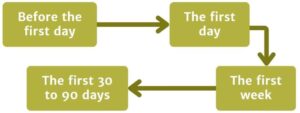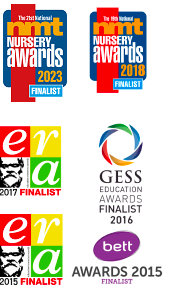In the Early Years sector, there is often a high demand for places from parents, especially ahead of the funding updates coming in April and September. To meet this demand and fill vacancies, Early Years settings must effectively manage their recruitment process and ensure a smooth onboarding experience for new employees. In this blog, we will explore the full cycle recruitment process, provide tips for handling recruitment in Early Years settings, and discuss the importance of managing employee onboarding.
What is the Full-Cycle Recruitment Process?
The full-cycle recruitment process involves handling the entire hiring operation from start to finish. It consists of the following steps:
Preparing: Defining the qualifications and characteristics of the ideal candidate for the role.
Sourcing: Advertise job vacancies and proactively search for potential applicants.
Screening: Review candidate applications and select those who best fit the role.
Selecting: Conduct interviews to gather more information about the candidates and make an informed decision.
Hiring: Identify the best candidate from the selection process and offer them the role.
Onboarding: Welcome the new employee and help them acclimate to their new position.

How Early Years settings can handle the recruitment process
Handling the whole recruitment process can be a daunting task, here are some tips to make everything run a bit smoother.
Preparing and Sourcing:
Use similar job titles to other vacancies in your area to ensure visibility and relevance. Clearly define the role, responsibilities, and requirements of the position to provide potential candidates with a comprehensive understanding of what is expected.
Highlight any unique aspects of your setting, such as specialised programs or a supportive work environment.
Emphasise your company values and brand to attract candidates who align with your organisation’s culture. Include essential information such as salary range and commuter details to provide transparency and assist candidates in assessing the role. Highlight and bold key information so that certain aspects of the job advert come across clearly.
If you are able, consider creating multiple adverts per role, each with a different wording or emphasis. This approach helps attract different applicants with diverse priorities and highlights various aspects of the position. Tailor the adverts to target specific candidate preferences or skill sets.
To expand your reach and attract a wider pool of candidates, make use of various job boards. Consider platforms such as Jobs by eyrecruit, Indeed, the gov.uk job board, and TotalJobs. Each platform has its own candidate pool, so posting on multiple boards will increase visibility and maximise your chances of finding suitable candidates.
Strategic Screening:
Upon receiving applications, it is important to promptly acknowledge and engage with the candidates. Utilise tools such as automated emails, text messages, and follow-up calls to maintain communication and demonstrate your interest in their application. Applicant tracking systems such as eyrecruit can simplify this process for you, with predefined email templates automatically sent to candidates when they submit their application and as they move to the screening stage. Regular communication in these early stages helps in building a positive candidate experience.
Gather as much relevant information as possible from the candidates as soon as you can. Consider the following key areas to inquire about:
- Look for relevant experience, certifications, and a passion for Early Years education
- Identify any red flags in the submitted resumes or CVs. Pay attention to inconsistencies, gaps in employment history, or anything that may raise concerns about the candidate’s suitability for the position
- Pre-screen applicants with key questions specific to the job requirements
- Send an application form for candidates to complete before the interview. This additional form will provide more detailed information about their education, skills, and professional background
- Check salary expectations or current salary to ensure alignment with your budget and avoid any potential mismatches
- Ask candidates to provide their qualification certificates ahead of the interview to verify their credentials against the requirements of the position
- Verify if the candidate’s commute is possible for them, making sure they can easily travel to the job location without any major obstacles
Take a proactive approach by actively searching for potential candidates through headhunting techniques. Explore platforms like CV libraries to review candidate CVs. Additionally, encourage your employees or industry contacts to refer qualified candidates who may align with the requirements of the role.
Interview Experience:
Send a clear invitation to an interview, including all necessary details:
- A clear date and time for the interview
- The name of the interviewer if possible
- Details about access to the nursery
- Commuter links and parking options, including if payment is needed for street parking
- Details of the interview format: Is it with a manager, will it include a room-based trial, etc
- Request for the application form and diversity form to be returned before the interview
- If they need ID at the interview
When sending interview invites through eyworks’ applicant tracking system eyrecruit, key interview information can be sent separately to the candidate and the interview team to ensure everyone receives the information whilst keeping personal email addresses hidden.
It is essential to provide a positive and welcoming experience during the interview stage. One way to achieve this is by setting up interview templates that will ensure a fair and consistent approach in evaluating candidates. This will help your team to assess candidates objectively, reduce biases, and provide a structured evaluation of their suitability for the role.
Use practical scenario questions during the interview process as a great way to assess candidates on their problem-solving and critical-thinking skills. By presenting candidates with real-life scenarios that they are likely to encounter on the job, you can evaluate their readiness for the role and ensure they have the skills necessary to thrive in your nursery.
Ensure you provide candidates with enough time to ask questions about the role and your setting. Encourage open communication as this can create a more positive and engaged interview environment.
Consider showcasing your nursery as part of the recruitment process, possibly through conducting a trial period within your setting. This will give candidates the chance to experience the nursery’s daily operations, meet staff members, and get a sense of the work environment. This method allows candidates to see first-hand how they could fit in and contribute to your team’s growth.
Making the Offer:
Ensure you clearly communicate the offer to the candidate. Make sure you outline important details like the role, salary, and benefits but be open to negotiation. A candidate may have alternative needs or wants to what you have offered, but you may be able to adjust your offer to suit the candidate as well as your setting.
Make sure to attach a job description to your offer so that the candidate is clearly aware of the roles and responsibilities they are undertaking when accepting the role.
Set a reasonable timeframe for the candidate to respond, they may need to take some time to consider their decision but it is important to set a deadline for responses so you can move on with your process in a timely manner. Also, ensure all necessary documentation is prepared for the next steps. To ensure you don’t miss a stage of this process, eyworks’ applicant tracking system eyrecruit allows you to assign candidates within the offer stage to an appropriate offer task or outcome, so that everyone involved in the recruitment process knows exactly what needs completing and the deadlines for this completion.
Express your enthusiasm and excitement about the candidate joining your team, this shows them that you are going to be warm and welcoming when they come on board.

How Early Years Settings Can Manage Employee Onboarding
Employee onboarding is crucial in ensuring a smooth transition for new hires. Here’s how Early Years settings can manage the onboarding process effectively:
Before the First Day:
Keep in contact with the new hire and provide them with important information and resources.
Inform the existing team about the new employee’s arrival to promote a welcoming environment.
Set up accounts and arrange a welcome kit to help the new hire feel prepared and valued.
The First Day:
Focus on providing a positive experience on the first day by conducting an orientation tour and introducing the new hire to the team.
Ensure the new employee has a clear understanding of their responsibilities and what is expected of them.
The First Week:
Start key employee training and induction, providing an overview of the company and its mission.
Check in regularly with the new hire to address any questions or concerns they may have.
The First 30 to 90 Days:
Aim for the employee to become proficient and independent in contributing to the nursery’s success.
Schedule a probation or review meeting to assess the new hire’s progress and provide feedback.
Continue checking in regularly to support their growth and address any ongoing training needs.
Effective recruitment and employee onboarding are essential in Early Years settings to meet parent demand and maintain efficient operations. By following a comprehensive Full-Cycle recruitment process and implementing strong onboarding strategies, Early Years settings can attract and retain talented staff who will contribute to the success of their nursery.

